
I believe that most forensic technicians in the forensic work at the crime scene and in the laboratory may sometimes have the following thought. Did we do the right thing now, didn’t the track look like it could be better than what we came up with? Would we use a different method? I think these thoughts can sometimes be in the head of forensics after a job done.
The positive thing about these considerations is that we question whether the methods we use can perhaps be done in a different way. Many years ago, CNA (Cyan Acrylate) was introduced for developing fingerprints. When heated, CNA emits a gas that causes fingerprints deposited on non-absorbent surfaces. Sometimes developed prints are also treated with Basic Yellow40 which can give a better contrast in the track.
Often the result with CNA development is very good, but unfortunately sometimes less good if the track material is exposed to dirt, rain or moisture before track securing.
Fig. 1, 2 and 3 show three different fingerprints on plastic material (plastic bags), which have been developed with CNA and Basic Yellow 40. Before the development, the bags were allowed to lie in the rain for an hour or so. The impression seen in Fig. 1 shows that some parts of the impression are completely missing (spotty coverage). These “spots” lack papillary lines- The two tracks in Fig. 2 and Fig. 3 show similar partial thinnings in the pattern. I think fingerprint examiners recognize these effects. It is likely that a trace exposed to water will have a certain negative impact on the trace quality after DNA development. But a reasonable question is, can really clean rainwater wash away all the substance that is in a fingerprint that was tried to develop with smoke particles from CNA. It is likely that the CNA smoke settles on the surface of the impression and does not go down into the deeper parts of the track.
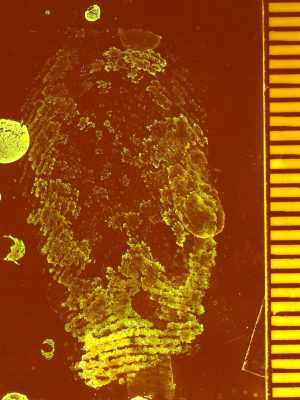
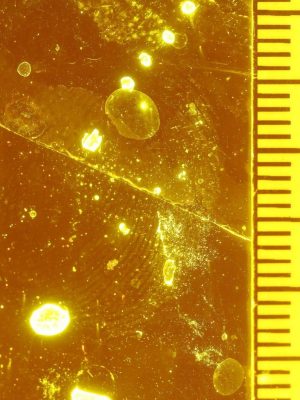
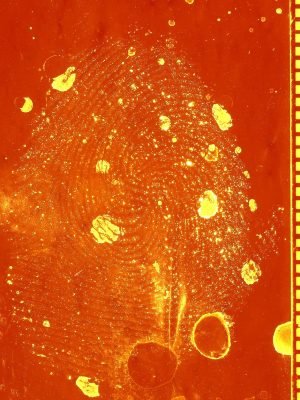
Fig 1
Fig 2
Fig. 3
Could a so-called color suspension be used for a further development attempt after the DNA development. The logical thing is that such a test should be done with a suspension of small paint particles. Wet Powder White contains titanium dioxide which has significantly smaller particles (about 1/1000 mm) when compared to carbon and iron oxide particles which are common in other suspensions. Thus, the three different tracks 1, 2 and 3 have also passed a “third attempt” with regular Wet Powder White without any special further treatment of the tracks.


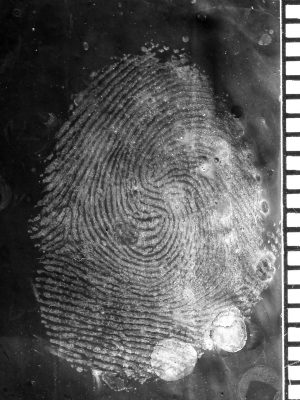
Fig 4
Fig 5
Fig.6
The result is shown in Fig. 4, 5 and 6 (Compare with 1, 2 and 3 respectively). With clarity, the tests show that marks on plastic bags left in the rain and developed with CNA and Basic Yellow 40 with barely usable quality can be “rescued” by a third attempt with Wet Powder White. Wet Powder Black, which is carbon-based and has slightly larger color particles, works worse.
Readers of this article may believe that the favorable results in described samples with Wet Powder White assume that the tracks must first be treated with CNA/Basic Yellow40 to obtain these favorable results. But it’s not. Fig. 7 and 8 show results with similar sample tracks developed only with Wet Powder White.
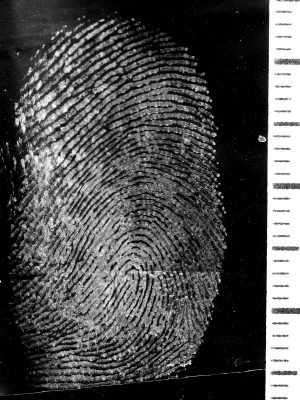
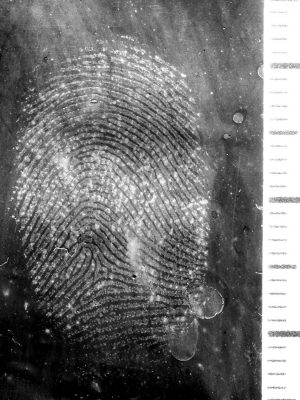
Fig 7
Fig 8
In conclusion, the author would like to add the following. Hopefully this topic is not fully developed. Right now, some tests are underway of another variant of Wet Powder with fluorescent color pigments. This could give good results if the fingerprint is deposited on a surface with disturbing variations in print and color. Hopefully this can be finished soon and appear in future issues of the newspaper BEVIS.
| Cookie | Duration | Description |
|---|---|---|
| cookielawinfo-checkbox-advertisement | 1 year | The cookie is set by GDPR cookie consent to record the user consent for the cookies in the category "Advertisement". |
| cookielawinfo-checkbox-analytics | 11 months | This cookie is set by GDPR Cookie Consent plugin. The cookie is used to store the user consent for the cookies in the category "Analytics". |
| cookielawinfo-checkbox-functional | 11 months | The cookie is set by GDPR cookie consent to record the user consent for the cookies in the category "Functional". |
| cookielawinfo-checkbox-necessary | 11 months | This cookie is set by GDPR Cookie Consent plugin. The cookies is used to store the user consent for the cookies in the category "Necessary". |
| cookielawinfo-checkbox-others | 11 months | This cookie is set by GDPR Cookie Consent plugin. The cookie is used to store the user consent for the cookies in the category "Other. |
| cookielawinfo-checkbox-performance | 11 months | This cookie is set by GDPR Cookie Consent plugin. The cookie is used to store the user consent for the cookies in the category "Performance". |
| viewed_cookie_policy | 11 months | The cookie is set by the GDPR Cookie Consent plugin and is used to store whether or not user has consented to the use of cookies. It does not store any personal data. |
| Cookie | Duration | Description |
|---|---|---|
| _ga | 2 years | This cookie is installed by Google Analytics. The cookie is used to calculate visitor, session, campaign data and keep track of site usage for the site's analytics report. The cookies store information anonymously and assign a randomly generated number to identify unique visitors. |
| _gat_gtag_UA_205394389_1 | 1 minute | This cookie is set by Google and is used to distinguish users. |
| _gid | 1 day | This cookie is installed by Google Analytics. The cookie is used to store information of how visitors use a website and helps in creating an analytics report of how the website is doing. The data collected including the number visitors, the source where they have come from, and the pages visted in an anonymous form. |
| CONSENT | 16 years 4 months 12 days 13 hours | These cookies are set via embedded youtube-videos. They register anonymous statistical data on for example how many times the video is displayed and what settings are used for playback.No sensitive data is collected unless you log in to your google account, in that case your choices are linked with your account, for example if you click “like” on a video. |
| Cookie | Duration | Description |
|---|---|---|
| IDE | 1 year 24 days | Used by Google DoubleClick and stores information about how the user uses the website and any other advertisement before visiting the website. This is used to present users with ads that are relevant to them according to the user profile. |
| NID | 6 months | This cookie is used to a profile based on user's interest and display personalized ads to the users. |
| test_cookie | 15 minutes | This cookie is set by doubleclick.net. The purpose of the cookie is to determine if the user's browser supports cookies. |
| VISITOR_INFO1_LIVE | 5 months 27 days | This cookie is set by Youtube. Used to track the information of the embedded YouTube videos on a website. |
| YSC | session | This cookies is set by Youtube and is used to track the views of embedded videos. |
| yt-remote-connected-devices | never | These cookies are set via embedded youtube-videos. |
| yt-remote-device-id | never | These cookies are set via embedded youtube-videos. |
| Cookie | Duration | Description |
|---|---|---|
| S | 1 hour | No description available. |